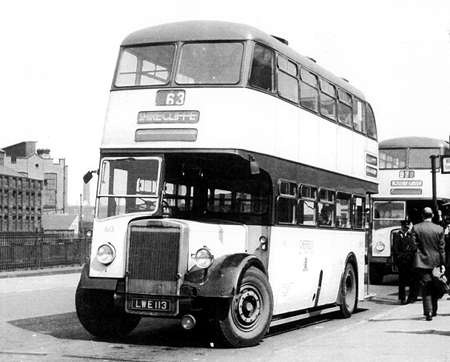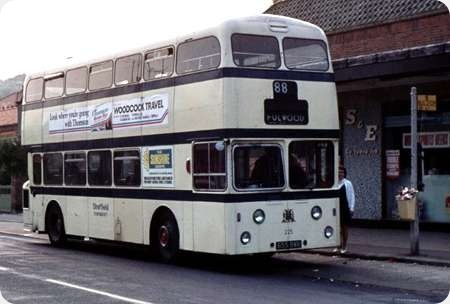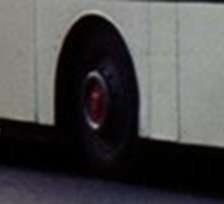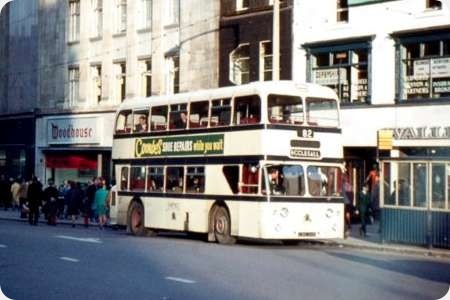Sheffield Corporation – Leyland Titan PD2 – LWE 113 – 613
Sheffield Corporation
1949
Leyland Titan PD2/1
Leyland H30/26R
There’s a bit of a bus jam in Sheffield High Street on 9th October 1965 as 613, one of the large batch of A fleet all Leyland PD2s leaves the stand for a trip to Millhouses. It takes three Inspectors to peruse the Alexander Regent V in the background, hope they move out of the way before the member of the small batch of 1952 all Leyland PD2/10 manages to squeeze past the back of the queue and continue its journey. This little scenario (minus Inspectors) was re enacted last Wednesday in exactly the same place as I passed by – quite a coincidence! Sheffield’s all Leyland PD2s all put in a good innings, at 16 years old 613 looks in fine fettle.
Photograph and Copy contributed by Ian Wild
04/02/16 – 16:58
Strange how Sheffield used two different liveries for differing bodywork designs. The three blue bands was probably the standard but most of the Roe bodies and these Leylands had blue around the windows. The big city fleets tended to be very standardised and bordering on the boring with large batches of buses that looked more of less the same. Sheffield was the exception as they purchased smaller batches of widely varying vehicle types right up to being absorbed into the PTE. A very interesting and always well turned out fleet. We had civic pride in those days.
Philip Halstead
05/02/16 – 14:54
On the subject of civic/local pride First has repainted buses in Leeds and Bradford into former operators liveries. For some reason these are always immaculately turned out by their respective garages unlike some of the standard liveried stuff Makes you think eh.
Chris Hough
06/02/16 – 06:57
Other Chris H – Have found a Bradford one – //tinyurl.com/h2n27cm – very smart!
Chris Hebbron
06/02/16 – 18:01
First certainly did Sheffield proud with retro-painted Geminis to celebrate the motor bus centenary in 2013. The superb paintwork depicted both old and new style of livery – a splendid selection of photos can be found at – www.flickr.com/photos/
John Darwent
06/02/16 – 18:02
A great photo Ian, brought back lots of memories! Having spent what might be described as my formative years in Sheffield I can only endorse the comments made about the variety of the fleet, though our local route 61/63 was almost always provided with the Roe bodied Leyland PD3s which replaced the trams. From memory, the buses were usually well maintained and clean inside (apart from the nicotine stained ceiling of the upper deck before smoking was banned)! Perhaps the presence of a conductor made a difference? Now living in Dorset and using First in Weymouth, I have to say that the buses are usually clean inside and out as well.
Stan Zapiec
07/02/16 – 07:17
The images of the First fleet in Sheffield using the older liveries just goes to show how awful the current so-called liveries are. The old ones had style and dignity, and looked good as well.
David Wragg
08/02/16 – 06:33
Nice photo! I visited relatives in Sheffield in the 1960s so delighted to see this. Was the very small plate on the radiators a note that the bus was `antifreezed`? Can’t remember!
Steve Milner
08/02/16 – 16:24
The ‘three blue bands’ vs the ‘blue window surrounds’ wasn’t the only variation to be found in the Sheffield livery either. On first repaint, buses had their roofs painted smudge grey instead of the cream they were delivered with, as seen in this photo of the same all-Leyland PD2, 613, laying over in Castlegate, alongside the River Don. I’ve heard it said that the shade of grey was actually derived from mixing the residue of the blue and cream paint tins.
In Ian’s photo of the bus, taken in its later years, the bus is seen to have had its original cream roof restored, part of the modifications made to the livery in the ‘Humpidge’ era of management. When C.T. Humpidge, formerly at Bradford, took over as General Manager from R.C. Moore in 1961, he made moves to do away with the practice of painting the roofs grey, and Roe bodies eventually lost their blue window surrounds, although intriguingly none of the Leyland ‘Farington’ style bodied PD2s so treated ever did, and retained their ‘blue window surrounds’ livery to the end. Humpidge also had matt black applied between the destination apertures to form a so called ‘consolidated display’, a move that still generates fierce debate amongst some older Sheffield enthusiasts even fifty plus years later!!
And yes Steve, that small plate affixed to the radiator read “STD – Do Not Drain”
Dave Careless
10/02/16 – 06:17
If the ‘consolidated’ destination was controversial, why did they not go all the way and just have a single line? Almost all photos that I have seen have one of the two screens showing blank and I have yet to find a reason for two of them being fitted!
David Todd
10/02/16 – 16:32
David – from memory there were a few destinations that required the use of both screens, Dore via Brocco Bank and Beighton Handsworth are two that come to mind. Also I think the lower blind had (generally) City services whilst the longer distance services (generally) appeared on the upper blind. Note that on the photo above from Dave, Shirecliffe is on the top blind (exception proves the rule) whilst on the bus behind, 97 Southey Green used to have via Longley Lane on the lower screen hence its appearance on the top screen.
Ian Wild
11/02/16 – 06:23
Fulwood via Rustlings Road was another, Ian. I remember being fascinated as a kid, on shopping trips into the city, seeing these PD2s storming along Fargate showing Roscoe Bank or Brocco Bank, they seemed like exotic destinations to me at the time, I don’t know why!
Ironically, even though they had the two apertures on the side over the platform, on route 1 they sometimes had to resort to carrying a red board with white lettering in the last nearside lower saloon window, reading ‘via Elm Lane’
Dave Careless
11/02/16 – 06:24
To emphasise Ian’s point, both blinds were used on a number of routes, 61/63 Beauchief and Woodseats Circular with Circular in the lower display spring to mind together with 74 Greystones Norton. So I think both blinds were in pretty frequent use.
Stan Zapiec
13/02/16 – 05:27
Or neither in use – instructions for the Stocksbridge locals were to "show blank" . . . despite "Garden Village" being available. If you follow this link //forum.sy-transport.co.uk/thread/13424/destination-blinds-lists (South Yorkshire Transport Forum, History, Destination Blinds) you’ll find listings from various destination blinds, including (if you work through the pages) various Sheffield Transport upper and lower and Y-type blind sets.
Philip Rushworth
12/06/19 – 06:37
Sorry, what’s this "B" fleet thing? Was there an "A" fleet as well, why?
Mark Chawner
12/06/19 – 10:53
…and a C Fleet as well! Others can explain better but it was all to do with the involvement of the railway companies.
Joe
12/06/19 – 12:41
Sheffield was a Joint Omnibus Committee where A fleet was wholly owned by Sheffield Corporation and operated within the city boundaries, C fleet was owned by the railways (LMS & LNER) and broadly speaking operated long distance routes often terminating at or near railway stations far afield. B fleet was jointly owned by corporation and railways and usually operated beyond the city boundaries but not so distant as C fleet. As might be expected there were many variations to this and buses from the B fleet especially could be seen on many A & C routes, buses from A fleet would often be seen on C fleet routes and a periodic mileage / income balancing would take place. Popular routes with hikers and ramblers would use vehicles from all fleets at peak weekends and Bank Holidays. See C.C Hall’s "Sheffield Transport" for a more detailed explanation. My very favourite fleet!!
Les Dickinson
Quick links to the - Comments Page - Contact Page - Home Page





